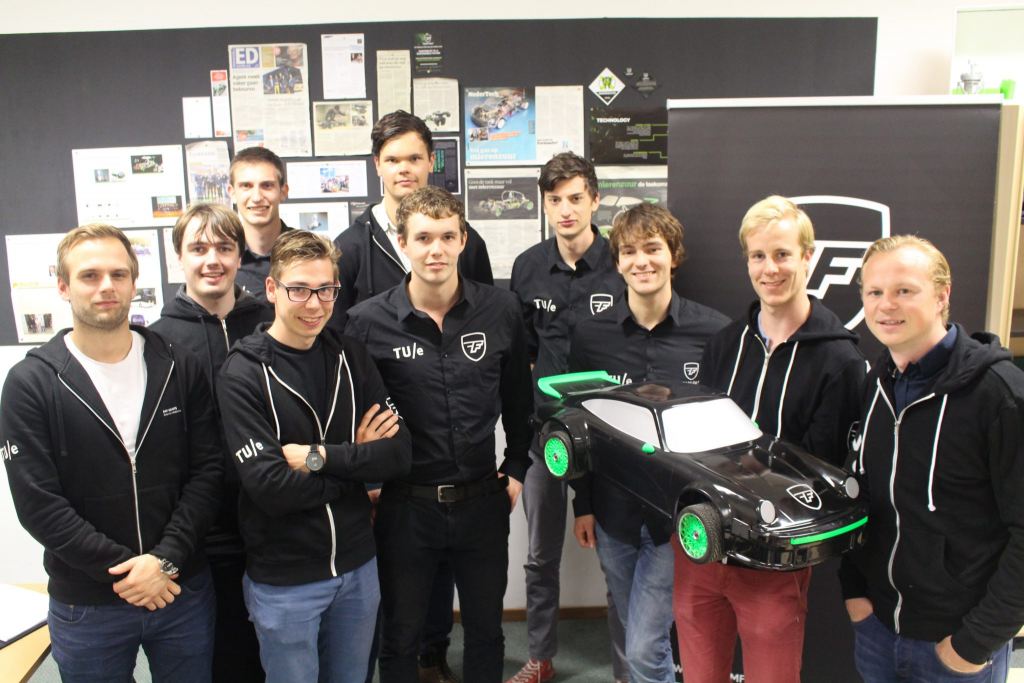
Ten startups from Eindhoven have been honoured with the Gerard and Anton Award 2016. The jury of the awards thinks these ten have all it takes to follow the footsteps of Gerard and Anton Philips who, 125 years ago, formed the first truly successful startup in the region. Every day we highlight one of those startups. Today: Team FAST.
Here’s everything on the Gerard & Anton Awards
In fact, Team FAST is not (yet) a startup but a TU/e student team. The 25+ students work on a sustainable energy solution for the transport sector: a car on formic acid. With a scale model of 1 metre the team proved that it was possible. The big work is yet to come, in the coming months the team will build a bus for sponsor VDL. Max Aerts guides us at the TU/e. “Compare us with a startup still in the research phase.”
The Jury:
This student team from the TU/e has a surprising alternative to both fossil fuels and hydrogen. Already demonstrated at a small scale, they are now building a Formic Acid driven bus. They also successfully closed their crowdfunding project.
The TU/e team is waiting for the last components trickling in at the new workspace at the Automotive Campus in Helmond. When everything is in, the construction of the upscaled system can begin. The prototype was successful earlier this year. “That was in January. That was a real kick. Not only our hard work got rewarded, but also we got the proof that it actually worked out as we thought it would do.”

Aerts walks into his the office and he puts the scaled model of the car on the table. He pulls of the cover, underneath there are a bunch of tubes and a little fuel tank. “Look, this is where the magic happens”, he jokes, meanwhile putting the cover back on. “In Helmond we are building everything on a much bigger scale. That’s really exciting, because we expect everything to work, but of course it’s never beyond doubt that this will actually be the case.” Team FAST believes formic acid can become the equivalent of gasoline. “The infrastructure for liquids is already available, so why not?”
How does it work?
With a reactor developed by the students, formic acid is converted into hydrogen with help of a catalyst. In the fuel cell the hydrogen is then converted in energy for the electro motor. “Cars on batteries are actually quite efficient, especially for commuter traffic. But if you aim on the transport sector, batteries are definitely inefficient. That’s because they’re relatively heavy and take up a lot of space. This means that the amount of cargo you can take with you is limited. Mobility on hydrogen is already better, but the downside of this method is that you have to store the hydrogen under high pressure, which makes it relatively costly. With formic acid all of this isn’t necessarily.”
Aerts says converting a gas station into a station that is suitable for the use of hydrogen costs between 700,000 and 1 million euro. “That’s really a lot of money. Converting gas stations into stations for formic acid use is much cheaper.”
Aren’t you anticipating on things?
Aerts has to laugh: “Before one thing goes right, you already come across ten other things that you have to solve. We keep on testing and optimizing things. Because we now know the small car works on formic acid, we know for sure the big one is going to ride as well. Probably not immediately at the first time, you have to stay creative en keep on getting ahead of problems. But it is difficult to predict if this will be the new standard. This is a great technique, but not always the best technique becomes mainstream. It all depends on which technique is embraced by the market.”

Aerts calls it an advantage that there already is an infrastructure for tanking natural gas. “With formic acid it’s easy to follow up on this structure, nothing is going to change for the customers. They keep on tanking gas the same way as they always used to do, the only difference is the sort of liquid that comes out of the pump.” For now, Team FAST is focusing on achieving the first goal: making the formic acid city bus roadworthy. If everything goes right this bus can drive before the end of this year.”
Biggest lesson?
“I would like to recommend everyone such a year like we had. It’s really interesting and you learn a lot of new things and people. Plus you get to see how big companies operate, because of this you get real good insights on how things work. I would lie if I said this isn’t a big plus on my resume. Someone in the team had a job interview the other day, and the only thing they talked about was Team FAST. We notice that people find it really interesting what we do. We are real pioneers, actually. This road has never been walked before. Of course it’s a real kick that we can potentially change the world. But we keep a down-to-earth mentality. We try not to think too much about it, but sometimes it sinks in: what if everything will work out as planned?” With a proud smile Aerts looks up. “We try to keep calm.”

